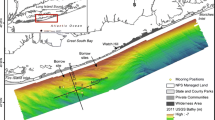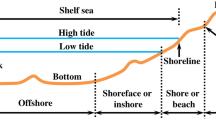Abstract
Shoreface-connected sand ridges are rhythmic bedforms that occur on many storm-dominated inner shelves. The ridges span several kilometers, are a few meters high, and they evolve on a timescale of centuries. A process-based model is used to gain a fundamental insight into the response of these ridges to extraction of sand. Different scenarios of sand extraction (depth, location, and geometry of the extraction area; multiple sand extractions) are imposed. For each scenario, the response timescale as well as the characteristics of the new equilibrium state are determined. Results show that ridges partially restore after extraction, i.e., the disturbed bathymetry recovers on decadal timescales. However, in the end, the ridge original sand volume is not recovered. Initially, most sand that accomplishes the infill of the pit originates from the area upstream of the extraction, as well as from the areas surrounding the pit. The contribution of the latter strongly decreases in the subsequent time period. Depending on the location of the pit, additional sand sources contribute: First, if the pit is located close to the downstream trough, the pit gains sand by reduction of sand transport from the ridge to this trough. Second, if the pit is located close to the adjacent outer shelf, the ridge recovery is stronger due to an import of sand from that area. Furthermore, pits that are located close to the nearshore zone have a weak recovery, deeper pits have longer recovery timescales, wide and shallow pits recover most sand, while multiple sand pits slow down the recovery process.














Similar content being viewed by others
References
Antia EE (1996) Shoreface-connected ridges in German and US Mid-Atlantic Bights: similarities and contrasts. J Coast Res 12(1):141–146
Bailard JA (1981) An energetics total load sediment transport model for a plane sloping beach. J Geophys Res 86(C11):10938–10954
Boers M, Sea DN (2005) Effects of a deep sand extraction pit. Tech. rep. Final report of the PUTMOR measurements at the lowered dump site. Rijksinstituut voor Kust en Zee/RIKZ, RIKZ/2005.001, The Hague. ISBN 90-369-3498-2
Brière C, Roos PC, Garel E, Hulscher SJMH (2010) Modelling the morphodynamics of the Kwinte Bank, subject to sand extraction. J Coast Res (SI51):117–126
Caballeria M, Coco G, Falqués A, Huntley DA (2002) Self-organization mechanisms for the formation of nearshore crescentic and transverse sand bars. J Fluid Mech 465:379–410
Calvete D, de Swart HE (2003) A nonlinear model study on the long-term behavior of shoreface-connected sand ridges. J Geophys Res 108(C5):3169. doi:10.1029/2001JC001091
Calvete D, Falqués A, de Swart HE, Walgreen M (2001) Modelling the formation of shoreface-connected sand ridges on storm-dominated inner shelves. J Fluid Mech 441:169–193
Castelle B, Ruessink BG (2011) Modeling formation and subsequent nonlinear evolution of rip channels: time-varying versus time-invariant wave forcing. J Geophys Res 117:F01308. doi:10.129/2011JF002141
Chase RRP (1979) The coastal longshore pressure gradient: temporal variations and driving mechanisms. J Geophys Res 84(C8):4898–4904
Coco G, Murray AB, Green MO, Hume T, Thieler R (2007) Sorted bedforms as self-organizing patterns. Part 2: complex forcing scenarios. J Geophys Res 112:F03016. doi:10.129/2006JF000666
Figueiredo A, Swift D, Clarke T et al (1981) Sand ridges on the inner Atlantic shelf of North America: morphometric comparisons with Huthnance stability model. Geo-Mar Lett 1(3–4):187–191
Figueiredo Jr. AG, Sanders JE, Swift DJP (1982) Storm-graded layers on inner continental shelves: examples from southern Brazil and the Atlantic coast of the central United States. Sediment Geol 31(3-4):171–190
Garnier R, Calvete D, Falqués A, Caballeria M (2006) Generation and nonlinear evolution of shore-oblique/transverse sand bars. J Fluid Mech 567:327–360. doi:10.1017/S0022112006002126
Green MO, Vincent CE, McCave IN, Dickson RR, Rees JM, Pearsons, ND (1995) Storm sediment transport: observations from the British North Sea shelf. Cont Shelf Res 15(8):889–912
Hommes S, Hulscher SJMH, Stolk A (2007) Parallel modeling approach to assess morphological impacts of offshore sand extraction. J Coast Res 23(6):1565–1579. doi:10.2112/06-0698.1
Jensen JH, Madsen ES, Fredsøe J (1999) Oblique flow over dredged channels. II: sediment transport and morphology. J Hydraul Eng 125(11):1190–1198
Knaapen MAF, Hulscher SJMH (2002) Regeneration of sand waves after dredging. Coast Eng 46(4):277–289
Lentz EE, Hapke CJ, Stockdon HF, Hehre RE (2013) Improving understanding of near-term barrier island evolution through multi-decadal assessment of morphologic change. Mar Geol 337:125–139
Longuet-Higgins MS, Stewart RW (1964) Radiation stresses in water waves: a physical discussion, with applications. Deep Sea Res 11(4):529–562
Mei CC, Stiassnie M, Dick KPY (2005) Theory and applications of ocean surface waves: linear aspects, vol 1. World Scientific, Singapore
Murray AB, Thieler ER (2004) A new hypothesis and exploratory model for the formation of large-scale inner-shelf sediment sorting and rippled scour depressions. Cont Shelf Res 24:295–315
Murray EB, Goldstein EB, Coco G (2013) The shape of patterns to come: from initial formation to long-term evolution. Earth Surf Process Landf 8. doi:10.1002/esp.3487
Niedoroda AW, Swift DJP (1981) Maintenance of the shoreface by wave orbital currents and mean flow: observations from the Long Island coast. Geophys Res Lett 8(4):337–340
Nnafie A, de Swart HE, Garnier R, Calvete D (2011) Formation of shoreface-connected sand ridges: effects of rigid-lid approach, quasi-steady approach and wave-topography feedbacks. In: Proceedings of the 7th IAHR symposium on River, Coastal and Estuarine Morphodynamics: RCEM2011. Abstract nr. Tsinghua University Press, Beijing, pp 2114–2123
NPS (2008) Environmental assessment Fire Island community short-term storm protection. Tech. rep., National Park Service, U.S. Department of the Interior, Washington
Parker G, Lanfredi NW, Swift DJP (1982) Seafloor response to flow in a southern hemisphere sand-ridge field: Argentine inner shelf. Sediment Geol 33(3):195–216
Roos PC, Hulscher SJMH (2006) Nonlinear modeling of tidal sandbanks: wavelength evolution and sand extraction. In: Smith JM (ed)Proceedings of the ICCE 2006. World Scientific, Singapore, pp 2761–2771, doi:10.1142/9789812709554_0233
Roos PC, Hulscher SJMH, de Vriend HJ (2008) Modelling the morphodynamic impact of offshore sandpit geometries. Coast Eng 55(9):704–715. doi:10.1016/j.coastaleng.2008.02.019
Schwab WC, Thieler ER, Allen JR, Foster DS, Swift BA, Denny JF (2000) Influence of inner-continental shelf geologic framework on the evolution and behavior of the barrier-island system between Fire Island Inlet and Shinnecock Inlet, Long Island, New York. J Coast Res 16(2):408–422
Schwab WC, Baldwin WE, Hapke CJ, Lentz EE, Gayes PT, Denny JF, List JH, Warner JC (2013) Geologic evidence for onshore sediment transport from the inner continental shelf: Fire Island, New York. J Coast Res 29(3):526–544. doi:10.2112/JCOASTRES-D- 12-00160.1
de Swart HE, Calvete D (2003) Non-linear response of shoreface-connected sand ridges to interventions. Ocean Dyn 53(3):270–277
Swift DJP, Parker G, Lanfredi NW, Perillo G, Figge K (1978) Shoreface-connected sand ridges on American and European shelves: a comparison. Estuar Coast Mar Sci 7(3):257–273
Thornton EB, Guza RT (1983) Transformation of wave height distribution. J Geophys Res 88(C10):5925–5938
Trowbridge JH (1995) A mechanism for the formation and maintenance of shore-oblique sand ridges on storm-dominated shelves. J Geophys Res 100(C16):16071–16086
van de Meene JWH, van Rijn LC (2000) The shoreface-connected ridges along the central Dutch coast—part 1: field observations. Cont Shelf Res 20(17):2295–2323
van de Meene JWH, Boersma JR, Terwindt JHJ (1996) Sedimentary structures of combined flow deposits from the shoreface-connected ridges along the central Dutch coast. Mar Geol 131(3–4):151–175
Van Rijn LC (1993) Principles of sediment transport in rivers, estuaries and coastal seas. Aqua Publications, Amsterdam
Vis-Star NC, de Swart HE, Calvete D (2007) Effect of wave-topography interactions on the formation of sand ridges on the shelf. J Geophys Res 112(C6):1978–2012. doi:10.1029/2006JC003844
Vis-Star NC, de Swart HE, Calvete D (2008) Patch behaviour and predictability properties of modelled finite-amplitude sand ridges on the inner shelf. Nonlinear Process Geophys 15:943–955
Acknowledgements
This work is part of the research program “Effect of self-organisation, interventions, sea level rise and storm chronology on the nonlinear dynamics of shoreface-connected sand ridges” (NWO-ALW, grant BOC21), which is financed by the Netherlands Organisation for Scientific Research (NWO).
Author information
Authors and Affiliations
Corresponding author
Additional information
Responsible Editor: Rockwell Geyer
This article is part of the Topical Collection on Physics of Estuaries and Coastal Seas 2012
Appendices
Appendix 1: Bottom evolution
The evolution of the bottom is governed by
where p(∼0.4) is the bed porosity, z b is the bed level, and q tot is the sediment transport. In this study, the latter quantity is decomposed into three contributions:
Here, q is defined in Eqs. (15) and (16), q mbs is the sediment transport due to the mean bottom slope (directed offshore), and q wa is the sediment transport induced by wave asymmetry (directed onshore). It is assumed that q mbs and q wa are alongshore uniform, so they depend only on x, t. Furthermore, z b = −H(x)+h(x, y, t), where H(x) is the mean depth profile in the case of a naturally evolving system.
Averaging Eq. (24) over longshore coordinate y yields
Note that, in the case of a naturally evolving system, < h > = 0 by construction. This means that q mbs + q wa = −< q > . Substitution of this result into Eq. (24) thus yields the mass balance given in Eq. (14) of the main paper.
Appendix 2: Recovery time t r versus slope β
Simulations (Fig. 14) show that recovery time t r is inversely proportional to bottom slope β, i.e., t r ∼ β −1. This relationship can be understood from Eq. (23), in which, for simplicity, only the dominant term (T 1) is considered. The result is
Upon decomposing velocity vector v and depth D in terms of their unperturbed components (which occur in the absence of bottom perturbations h and only depend on x) and perturbed components, i.e.
and using the fact that ratio h/H << 1, Eq. (25) is approximated as
From this, an equation governing the domain-averaged potential energy of the bottom perturbations is derived by multiplying the above equation with h and integrating over the domain (Garnier et al. 2006). The result is
in which the overbar denotes domain averaging (i.e., \(\frac {1}{LL_{y}}\int \int \cdot ~ dx dy\)). The first term on the r.h.s is 0 because of periodic boundary conditions at the lateral boundaries (note that K b = K b (x)). An estimate of the recovery time t r follows from
where scales are denoted by brackets [.]. A scale for the term in the denominator, \(\left [\overline {\frac {K_{b}v'}{H}\frac {\partial }{\partial y}\frac {1}{2}h^{2}}\right ]\), is found using the mass balance Eq. (11) (assuming rigid-lid, i.e., ∇⋅(D v)≃0):
Note that the first three terms on the l.h.s. dominate over the last five terms, because \(\frac {\partial H}{\partial x}=\beta \sim 10^{-3} << 1\), h << H and (u, v′) << V 0. Hence, term \([v'\frac {\partial h}{\partial y}]\sim [u\frac {\partial H}{\partial x}]\sim \beta [u]\). Since \([u]\sim \frac {[h]}{H_{0}}[V_{0}]\), it follows that \([v'\frac {\partial h}{\partial y}]\sim \beta \frac {[h]}{H_{0}}[V_{0}]\). Scale [t r ] can thus be approximated to be
Rights and permissions
About this article
Cite this article
Nnafie, A., de Swart, H.E., Calvete, D. et al. Modeling the response of shoreface-connected sand ridges to sand extraction on an inner shelf. Ocean Dynamics 64, 723–740 (2014). https://doi.org/10.1007/s10236-014-0714-9
Received:
Accepted:
Published:
Issue Date:
DOI: https://doi.org/10.1007/s10236-014-0714-9




